clock Oldsmobile Aurora 1998 Owner's Manuals
[x] Cancel search | Manufacturer: OLDSMOBILE, Model Year: 1998, Model line: Aurora, Model: Oldsmobile Aurora 1998Pages: 380, PDF Size: 19.75 MB
Page 146 of 380

When the trip is complete a chime will sound and the
display will show:
TRIP
COMPLETE
The trip complete message will go off when you
press any button,
or when you turn your ignition off,
then on. The display returns to the mode displayed
prior to the interruption.
Elapsed Time (ET)
When the ignition is on, the DIC can be used as a
stopwatch. The display will show hours and minutes.
The elapsed time indicator will record up to
100 hours,
then it will reset to zero and continue counting. Press
ET, and the display will show the amount of time that
has elapsed since the elapsed time indicator was last
reset (not including time the ignition is off), such
as:
01:OS ELAPSED TIME
To reset elapsed time to zero, press RESET while the
elapsed time
is displayed.
Date
Press DATE to display the date. To change the date,
press DATE then RESET. The following display
will appear:
MONTH? XX/DD/YY
MM,
DD and YY represent the month, date and year
you currently have
in your system. Check to make sure
your clock is in the correct AM or PM mode.
Notice that each key has a number. Push the key
to
enter the number. The first XX’s will flash until you
enter the first digit for the month. You don’t need to
enter the leading zero
if the number is under 10. Press
ENTER after you’ve entered the month. The display will change to:
DAY? MM/XX/YY
Set the day just
as you set the month. After the day entry
is made, press ENTER and the display will change to:
YEAR? MM/DD/XX
2-80
Page 151 of 380
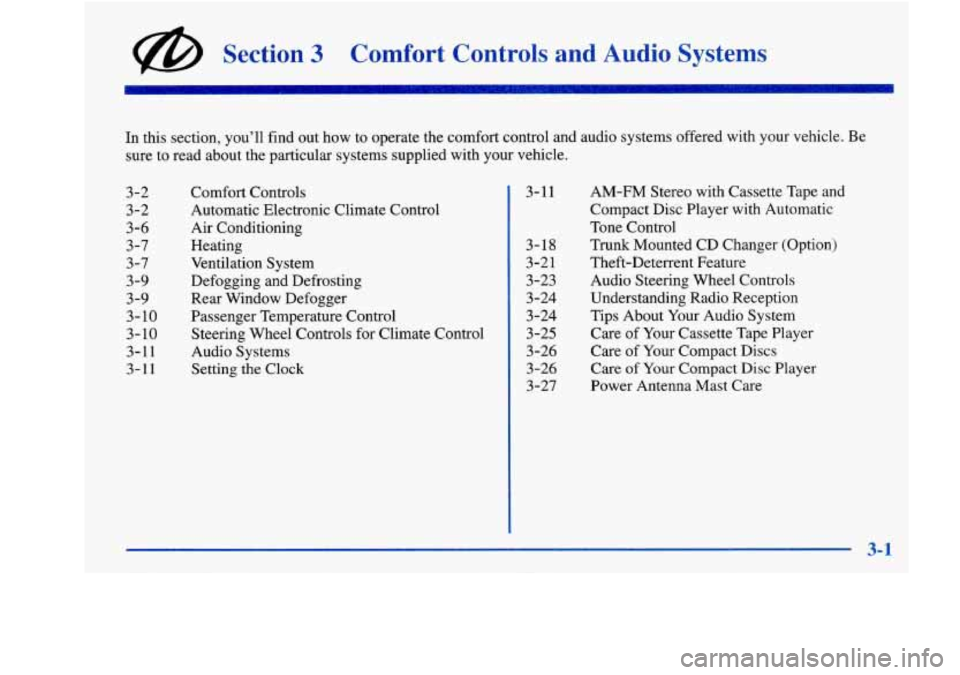
@ Section 3 Comfort Controls and Audio Systems
In this section, you’ll find out how to operate the comfort control and audio systems offered with your vehicle. Be
sure to read about the particular systems supplied with your vehicle.
3-2 3-2
3-6
3-7 3-7
3-9
3-9
3- 10
3-10
3-11
3-11
Comfort Controls
Automatic Electronic Climate Control
Air Conditioning
Heating Ventilation System
Defogging and Defrosting
Rear Window Defogger
Passenger Temperature Control Steering
Wheel Controls for Climate Control
Audio Systems Setting
the Clock 3-11
3-18
3-21
3-23 3 -24
3 -24
3-25
3-26
3-26
3-27 AM-FM
Stereo with Cassette Tape and
Compact Disc Player with Automatic
Tone Control
Trunk Mounted CD Changer (Option)
Theft-Deterrent Feature
Audio Steering Wheel Controls
Understanding Radio Reception
Tips About Your Audio System
Care of Your Cassette Tape Player
Care of Your Compact Discs
Care of Your Compact Disc Player
Power Antenna Mast Care
Page 161 of 380

Audio Systems
Your Delco Electronics audio system has been designed
to operate easily and give years of listening pleasure.
You will get the most enjoyment out of it
if you acquaint
yourself with it first. Find out what your Delco
Electronics system can do and how to operate all its
controls, to be sure you’re getting the most out of the
advanced engineering that went into it.
AM-FM Stereo with Cassette Tape and
Compact
Disc Player with Automatic
Tone Control
Setting the Clock
Press and hold HR until the correct hour appears. The
letter
A or P may appear on the display for AM or PM.
Then, press and hold
MN until the correct minute
appears.
The clock may be set with the ignition on
or off.
Standard Radio -- Base@ Not Shown
If your vehicle is equipped with the Base@ AM-FM
Stereo with Cassette Tape and Compact Disc Player (not
shown), automatic tone control is not available. Your radio
will have
a MUTE button rather than a TONE button.
Playing the Radio
PWR-VOL: Press this knob to turn the system on and
off.
To increase volume, turn the knob to the right. Turn
it to
the left to decrease volume.
3-11
Page 162 of 380

RCL: Press this button briefly to recall the station being
played or
to display the clock. To change what is
normally shown on the display (station or time), press
the RCL button until you
see the display you want, then
hold the RCL button until the display flashes.
If you
press the button when the ignition is off, the clock will
show for a few seconds.
MUTE: Press this button to silence the system. Press it
again
to turn on the sound. (This button is available on
the BaseB radio only.)
Finding a Station
AM-FM:
Press this button to switch between AM, FMl
and FM2. The display shows your selection.
TUNE: Press this knob lightly so it extends. Turn it to
choose radio stations. Push the knob back into its stored
position when you’re not using it.
SEEK: Press the up or down arrow to go to the next
higher or lower station and stay there. The sound will
mute while seeking.
SCAN: Press this button and release it to listen to
stations for a few seconds. The radio will go to
a station,
stop for a few seconds, then
go on to the next station.
Press the button again to stop scanning. The sound will mute while scanning, and SCAN will appear on the
display.
If you press SCAN for more than two seconds,
the radio will change to
P SCAN mode. P SCAN will
appear on the display.
PUSHBUTTONS: The five numbered pushbuttons let
you return to your favorite stations. You can
set up to
15 stations (five AM, five FM1 and five FM2). Just:
1.
2.
3.
4.
5.
6.
Turn the radio on.
Press AM-FM to select the band.
Tune in the desired station.
Press TONE to select the equalization that best suits
the type of station selected. (This function is not
available on the Bose radio.)
Press and hold one of the five numbered buttons.
The sound will mute. When it returns, release the
button. Whenever you press that numbered button,
the station you set will return and the tone that you
selected will also be automatically selected for that
button. (The tone will not automatically return on the
Bose radio.)
Repeat the steps for each pushbutton.
Page 190 of 380
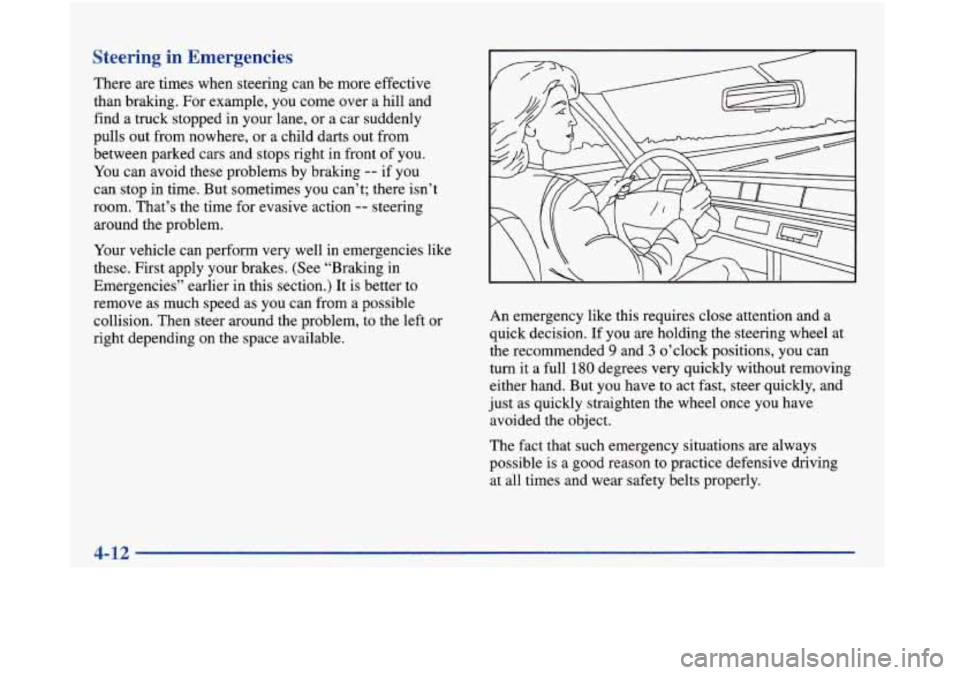
Steering in Emergencies
There are times when steering can be more effective
than braking. For example, you come over a hill and
find a truck stopped in your lane, or a car suddenly
pulls out from nowhere, or a child darts out from
between parked cars and stops right in front of you.
You can avoid these problems by braking -- if you
can stop in time. But sometimes you can’t; there isn’t
room. That’s the time for evasive
action.-- steering
around the problem.
lour vehicle can perforhl v2vL%ell in emergencies like
these. First apply your brakes. (See “Braking in
Emergencies” earlier in this section.) It is better to
remove as much speed as you can from a possible
collision. Then steer around the problem, to the left or
right depending on the space available. An
emergency like this requires close attention and a
quick decision.
If you are holding the steering wheel at
the recommended
9 and 3 o’clock positions, you can
turn it a full
180 degrees very quickly without removing
either hand. But you have to act fast, steer quickly, and
just as quickly straighten the wheel once you have
avoided the object.
The fact that such emergency situations are always
possible is a good reason to practice defensive driving
at all times and wear safety belts properly.
I
4-12
Page 259 of 380
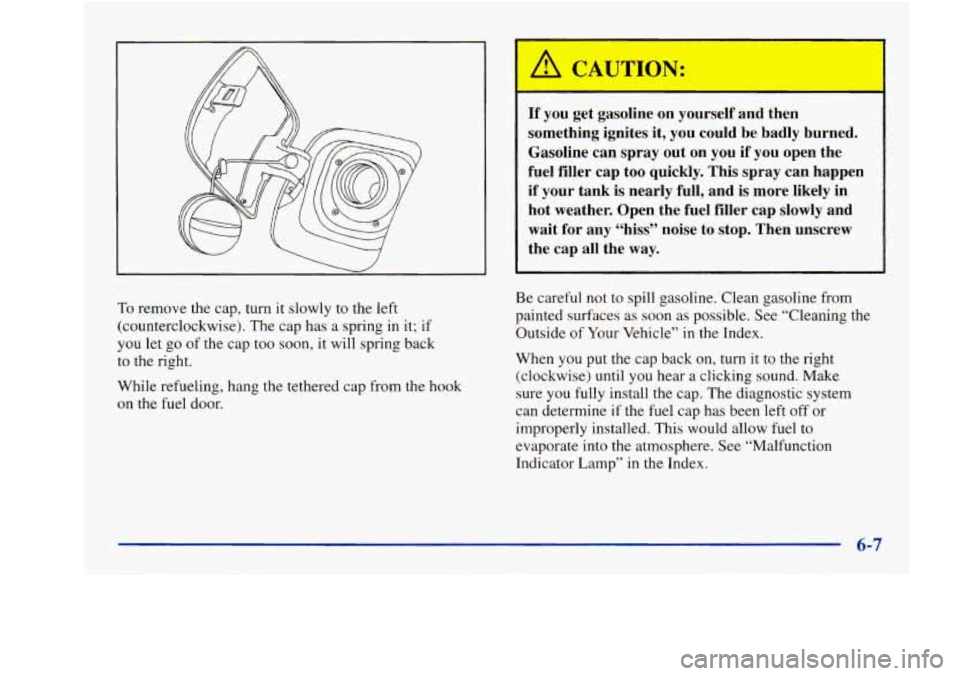
To remove the cap, turn it slowly to the left
(counterclockwise). The cap has a spring in it; if
you let go of the cap too soon, it will spring back
to the right.
While refueling, hang the tethered cap from the hook
on the fuel door.
If you get gasoline on yourself and then
something ignites
it, you could be badly burned.
Gasoline can spray out on you if you open the
fuel filler cap too quickly. This spray can happen
if your tank
is nearly full, and is more likely in
hot weather. Open the fuel filler cap slowly and
wait
for any “hiss” noise to stop. Then unscrew
the cap all the way.
Be careful not to spill gasoline. Clean gasoline from
painted surfaces as soon as possible. See “Cleaning the
Outside of Your Vehicle” in the Index.
When you put the cap back
on, turn it to the right
(clockwise) until you hear a clicking sound. Make
sure you fully install
the cap. The diagnostic system
can determine if the fuel cap has been left off or
improperly installed. This would allow fuel to
evaporate into the atmosphere. See “Malfunction
Indicator Lamp”
in the Index.
6-7
Page 287 of 380
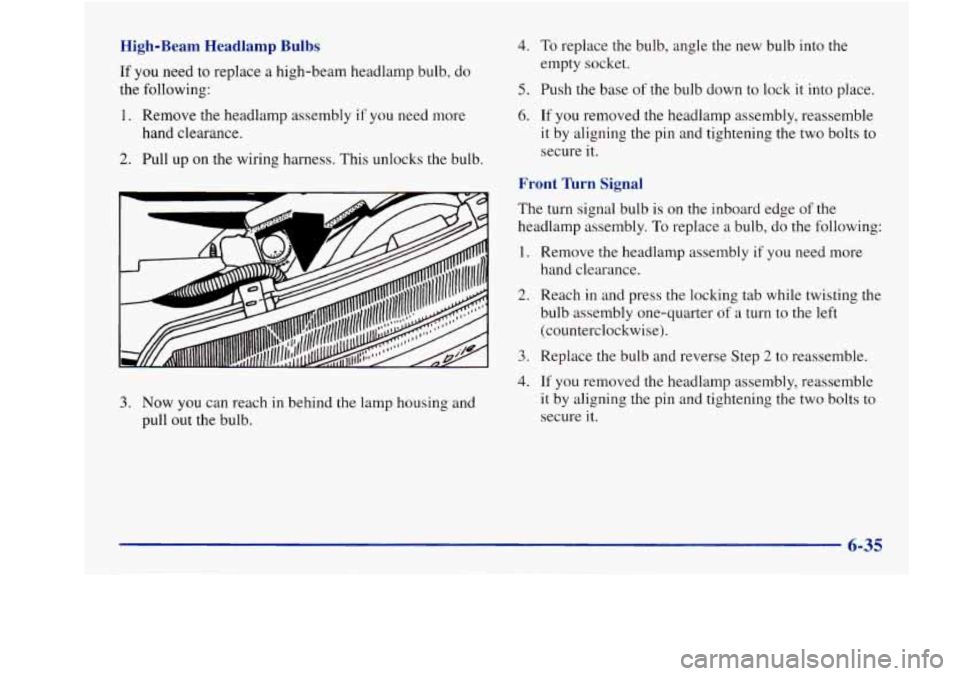
High-Beam Headlamp Bulbs
If you need to replace a high-beam headlamp bulb, do
the following:
1. Remove the headlamp assembly if you need more
hand clearance.
2. Pull up on the wiring harness. This unlocks the bulb.
1.
4. To replace the bulb, angle the new bulb into the
empty socket.
5. Push the base of the bulb down to lock it into place.
6. If you removed the headlamp assembly, reassemble
it by aligning the pin and tightening the two bolts
to
secure it.
Front Turn Signal
The turn signal bulb is on the inboard edge of the
headlamp assembly.
To replace a bulb, do the following:
2.
3.
4.
3. Now you can reach in behind the lamp housing and
pull out the bulb. Remove
the headlamp assembly
if you need more
hand clearance.
Reach in and press the locking tab while twisting the
bulb assembly one-quarter
of a turn to the left
(counterclockwise).
Replace the bulb and reverse Step
2 to reassemble.
If you removed the headlamp assembly, reassemble
it by aligning the pin and tightening
the two bolts to
secure it.
6-35
Page 294 of 380

5. Twist the socket one-quarter of a turn to the left
(counterclockwise) and pull to remove.
6. Replace the bulb and reverse Steps 1 through 4 to
replace the assembly and tighten the bolts.
Interior Lamps
Front and Rear Reading Lamps
To change the bulbs in the front and rear reading lamps,
do the following:
1. Carefully insert a flat head screwdriver in the slot
2. Gently pry the lens cover away to expose the reading
3. Remove the bulb from its assembly and install a
between the lens
cover and molding.
lamp bulb. The lens cover should
pop off.
new bulb.
4. Snap the lens cover back in place.
6-42
Page 365 of 380
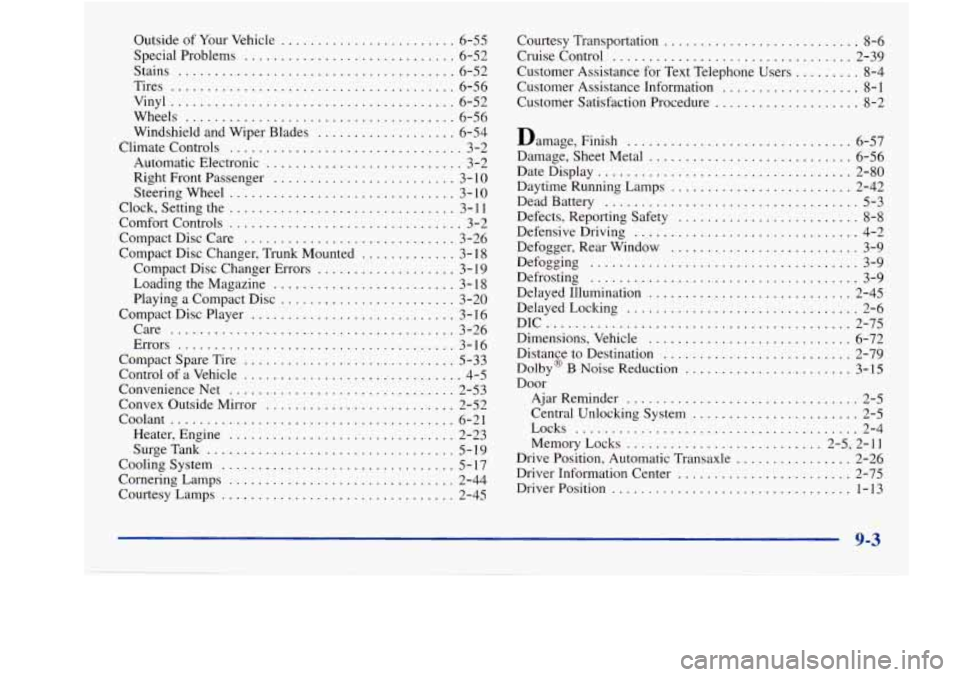
Outside of Your Vehicle ........................ 6-55
Special Problems
............................. 6-52
Stains
...................................... 6-52
Tires
....................................... 6-56
Vinyl
....................................... 6-52
Wheels
..................................... 6-56
Windshield and Wiper Blades
................... 6-54
Climate Controls
................................ 3-2
Automatic Electronic
........................... 3-2
Right Front Passenger
......................... 3- 10
SteeringWheel
............................... 3-10
Clock. Setting the
............................... 3- 11
Comfort Controls ................................ 3-2
Compact Disc Care
............................. 3-26
Compact Disc Changer. Trunk Mounted
............. 3- 18
Compact Disc Changer Errors
................... 3- 19
Loading the Magazine
......................... 3- 18
Playing a Compact Disc
........................ 3-20
Compact Disc Player
............................ 3-16
Care
....................................... 3-26
Errors
...................................... 3-1 6
Compact Spare Tire
............................. 5-33
Control of
a Vehicle .............................. 4-5
ConvenienceNet
............................... 2-53
Convex Outside Mirror
.......................... 2-52
Coolant
....................................... 6-21
Heater. Engine
............................... 2-23
SurgeTank
.................................. 5-19
Cooling System
................................ 5- 17
Cornering Lamps ............................... 2-44
Courtesy Lamps
................................ 2-45 Courtesy
Transportation
........................... 8-6
Cruise Control
................................. 2-39
Customer Assistance for Text Telephone Users
......... 8-4
Customer Assistance Information
................... 8-1
Customer Satisfaction Procedure .................... 8-2
Damage. Finish
............................... 6-57
Damage. Sheet Metal
............................ 6-56
DateDisplay
................................... 2-80
Daytime Running Lamps
......................... 2-42
Dead Battery
................................... 5-3
Defensive Driving
............................... 4-2
Defogger. Rear Window
.......................... 3-9
Defogging
..................................... 3-9
Defrosting
..................................... 3-9
Delayed Illumination
............................ 2-45
DelayedLocking
................................ 2-6
DIC
.......................................... 2-75
Dimensions. Vehicle
............................ 6-72
Distance to Destination
.......................... 2-79
Door Defects.
Reporting Safety
......................... 8-8
Dolby@ B Noise Reduction ....................... 3-15
Ajar Reminder
................................ 2-5
Central Unlocking System
....................... 2-5
Locks
....................................... 2-4
Memory Locks
........................... 2-5. 2-11
Drive Position. Automatic Transaxle
................ 2-26
Driver Information Center
........................ 2-75
DriverPosition
................................. 1-13
9-3